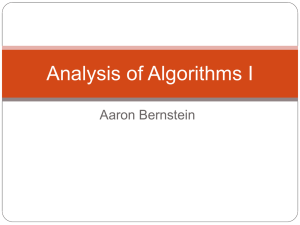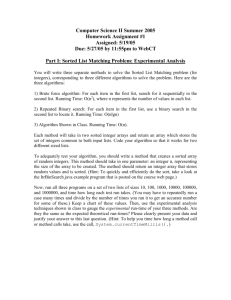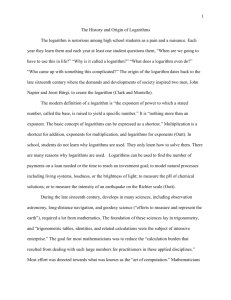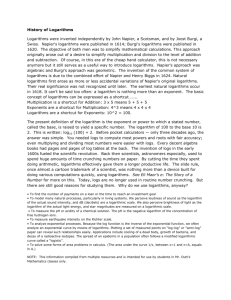Robert Burn on Napier - Some Mathematical Works of the 17th
advertisement
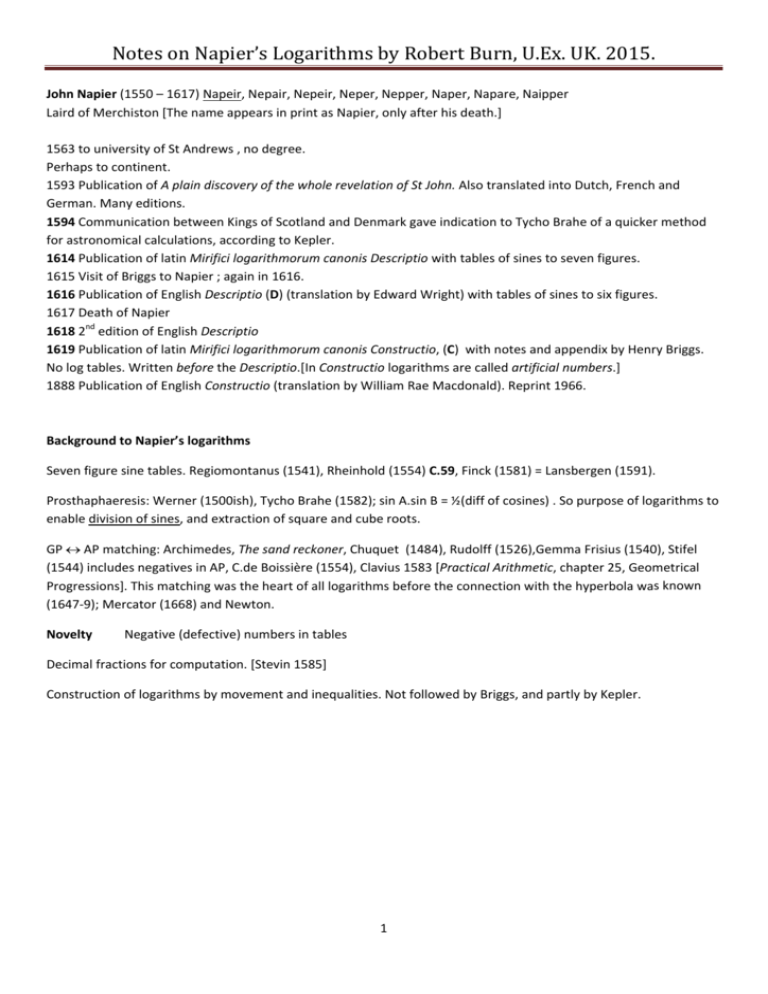
NotesonNapier’sLogarithmsbyRobertBurn,U.Ex.UK.2015.
John Napier (1550 – 1617) Napeir, Nepair, Nepeir, Neper, Nepper, Naper, Napare, Naipper Laird of Merchiston [The name appears in print as Napier, only after his death.] 1563 to university of St Andrews , no degree. Perhaps to continent. 1593 Publication of A plain discovery of the whole revelation of St John. Also translated into Dutch, French and German. Many editions. 1594 Communication between Kings of Scotland and Denmark gave indication to Tycho Brahe of a quicker method for astronomical calculations, according to Kepler. 1614 Publication of latin Mirifici logarithmorum canonis Descriptio with tables of sines to seven figures. 1615 Visit of Briggs to Napier ; again in 1616. 1616 Publication of English Descriptio (D) (translation by Edward Wright) with tables of sines to six figures. 1617 Death of Napier 1618 2nd edition of English Descriptio 1619 Publication of latin Mirifici logarithmorum canonis Constructio, (C) with notes and appendix by Henry Briggs. No log tables. Written before the Descriptio.[In Constructio logarithms are called artificial numbers.] 1888 Publication of English Constructio (translation by William Rae Macdonald). Reprint 1966. Background to Napier’s logarithms Seven figure sine tables. Regiomontanus (1541), Rheinhold (1554) C.59, Finck (1581) = Lansbergen (1591). Prosthaphaeresis: Werner (1500ish), Tycho Brahe (1582); sin A.sin B = ½(diff of cosines) . So purpose of logarithms to enable division of sines, and extraction of square and cube roots. GP AP matching: Archimedes, The sand reckoner, Chuquet (1484), Rudolff (1526),Gemma Frisius (1540), Stifel (1544) includes negatives in AP, C.de Boissière (1554), Clavius 1583 [Practical Arithmetic, chapter 25, Geometrical Progressions]. This matching was the heart of all logarithms before the connection with the hyperbola was known (1647‐9); Mercator (1668) and Newton. Novelty Negative (defective) numbers in tables Decimal fractions for computation. [Stevin 1585] Construction of logarithms by movement and inequalities. Not followed by Briggs, and partly by Kepler. 1 NotesonNapier’sLogarithmsbyRobertBurn,U.Ex.UK.2015.
Models of Napier’s logarithms: logsines for each minute of arc from sin 90= 107 to sin 1’ = 2909. 1. Nlog y = 107 ln 107/y. E.W.Hobson 1914, published lecture. Napier and the Invention of Logarithms, Cambridge Pro: Deduced from: C.25 Speed y’ = ky; C.23 x’ = const. Initially C.27 x = 0, y = 107; and C.26 x’ = ‐y’. Taking the constant x’ = 1, we get y’ = ‐y/107 , then integrate diff.eqn. Anti: C.1, no obvious GP. C.32 proved but C.36 not proved but needed for C.39. Anachronistic as no natural logarithms before 1649, and certainly no identification of e by Napier. Also continuity of speed not articulated by Napier, though seemingly implied by C.36. 2. Nlog 107(1 – 10‐7)x = x. F.Cajori 1913 (Am.Math. Monthly) Anti‐logs, as Whiteside. Pro: Supported by C.1, Table 1 (C.16) and remarks about table 1 in C.21. Fits C.32, C.37, C.38 (for specific terms of GP). Anti: None of (1 – 10‐5), (1 – 1/2000) or (1 – 1/100) belong to the GP (1 – 10‐7)n. Much of table 3 does not form a GP. C.30 appears to rule out equal first steps along AP and GP, but C.31 reinstates. Universal use of C.36 needs continuity of velocity. 3. Nlog y = 107log1/ey/107 (Macdonald translation 1888 page 91, also Glaisher in Tercenternary volume, p.65) Although identical to the first model (and therefore prone to the same objections) the derivation is from model 2. Since (1 – 1/n)n 1/e, after Euler, (1 – 10‐7)^107 is close to but less than 1/e. Thus model 2 may be very nearly rewritten Nlog 107(1/e)n/10000000 = n/107 , which is equivalent to model 3. 2 NotesonNapier’sLogarithmsbyRobertBurn,U.Ex.UK.2015.
Definition of logarithm Descriptio. Ch.1. Def.6 The Logarithme therefore of any sine is a number very nearly expressing the line, which increased equally in the mean time, whiles the line of the whole sine decreased proportionally into that sine, both motions being equal‐timed, and beginning equally swift. As for example, Let the two figures going afore bee here repeated, and let B bee moved always, and every where with equal, or the same swiftnesse wherewith b beganne to bee moved in the beginning, when it was in a. Then in the first moment let b proceed from A to C, and in the same time let b move proportionally from a to c, the number defining or expressing AC shall be the Logarithme of the line, or sine cZ. Then in the second moment let B bee moved forward from C to D. And in the same moment or time let b be moved proportionally from c to d, the number defining AD, shall be the Logarithme of the sine dZ. So in the third moment let B go forward equally from D to E, and in the same moment let b be moved forward proportionally from d to e, the number expressing AE the Logarithme of the sine eZ. Also in the fourth moment, let B proceed to F, and b to f, the number AF shall be the Logarithme of the sine fZ. And keeping the same order continually Constructio 26 The logarithm of a given sine is that number which has increased arithmetically with the same velocity throughout as that with which radius began to decrease geometrically, and in the same time as radius has decreased to the given sine. Let the line TS be radius, and dS a given sine in the same line; let g move geometrically from T to d in certain determinate moments of time. Again, let bi be another line, infinite towards i, along which, from b let a move arithmetically with the same velocity as g had at first when at T; and from the fixed point b in the direction of i let a advance in just the same moments of time up to the point c. The number measuring the line bc is called the logarithm of the given sine dS. 3 NotesonNapier’sLogarithmsbyRobertBurn,U.Ex.UK.2015.
(according to the former definition) the number of AG shall be the Logarithme of the sine gZ. AH the Logarithme of the sine hZ. AI the Logarithme of the sine iZ. AK the Logarithme of the sine kZ, and so forth infinitely. In the Descriptio definition of logarithms (definition 6) is immediately preceded (without comment) by Definition 5, and in the Constructio, the definition of logarithms (26) is preceded by 25. Descriptio, Ch.1, Definition 5 Seeing that there may be a slower and a swifter motion given than any motion, it shall necessarily follow, that there may be a motion given of equal swiftness to any motion (which we define to be neither swifter nor slower). Constructio, from section 25 For we observe that a moving point is declared more or less swift, according as it is seen to be borne over a greater or less space in equal times. Hence the ratio of the spaces traversed is necessarily the same as that of the velocities. But the ratio of the spaces traversed in equal times, T1,12,34,45 &c., is that of the distances TS, 1S, 2S, 3S, 4S, &c.. Hence it follows that the ratio of one to another of the distances of g from S is the same as that of the velocities of g at the points T, 1, 2, 3, 4, &c., respectively. To a modern reader, the Descriptio definition sounds like a version of an intermediate value theorem for velocities. But for Aristotle, velocity was not a magnitude, since it was not a ratio of homogeneous entities. It was none the less possible to compare velocities by comparing distances travelled over the same time interval, as for Achilles and the tortoise. In the parallel statement in the Constructio, where the ratio of speeds is equated to the ratio of spaces traversed, the velocities at T, 1, 2, 3,… in the last sentence are thus equal to the velocities over the segments T1, 12, 23, 34…, according to Napier’s statements in the preceding sentences. Napier reiterates the use of equal time intervals for both progressions. Notice the repeated use of the phrase ‘certain determinate moments of time’ in the two definitions of logarithm. This view of velocity gives no means of determining instantaneous velocity, and the phrase ‘certain determinate moments of time’ would be superfluous if velocity were changing continuously. There was some discussion of varying speed in the 14th century, but the thinking which led to the concept of acceleration, comes in Galileo’s Discourses on Two New Sciences (1633‐7). My own preferred model for Napier’s definition of logarithm is in fig.1, said to have been used by Edmund Gunter (1581‐1626) a colleague of Briggs [Hutton, Mathematical tables, p.84] and later by Huygens. 4 NotesonNapier’sLogarithmsbyRobertBurn,U.Ex.UK.2015.
In Figure 1, the arithmetic progression is along the horizontal axis and the geometric progression is along the vertical axis. Napier invariably drew the two axes parallel. The ‘curve’ in figure 1 has been drawn with short straight line segments, but this is not visually evident. In figure 2, a small part of the graph has been enlarged, according to Napier’s statements about velocity in C.25. At this point many commentators on Napier take the heading of Constructio 25 “A geometrically moving point approaching a fixed one has its velocities proportionate to its distances from the fixed one.”(which implies that the ‘subtangent’ to this ‘curve’ is of constant length) and translate it into the differential equation dy/dx = ‐ky, ignoring the subsequent explanation by Napier. The continuity of velocities is then implicit. There is indeed a problem with Napier’s development for which continuity of velocities would provide one solution. The problem is that the four geometric progressions which Napier uses to construct his three Tables, in C.16‐20, namely with common ratios 107(1 – 10‐7)n, 107(1 – 10‐5)n, 107(1 – 1/2000)n and 107(1 – 10‐2)n are disjoint apart from their first terms, and table III (C.20) consists of products of terms from the last two progressions. How then may Napier apply properties of a single geometric progression to all these different ones and their products, as he will do consistently from Constructio 36 onwards? Constructio 36 states “The logarithms of similarly proportioned sines are equidifferent.” Descriptio ch.2 Proposition 1 The Logarithmes of proportional numbers and quantities are equally differing. As for example. The Logarithmes of the proportionall sines, namely cz which is to ez as hz is to kz are respectively the numbers defining AC, AE, AH, AK, (as is manifest by the 6 Definition.) Now AC and AE differ by the difference CE, and AH and AK by the difference HK. But by the first definition and his corollary CE and HK are equal: therefore the Logarithmes of the foresaid proportional sines are equally differing. And so in all proportionals. For what affections and symptoms the Logarithmes have gotten in their first beginning and generation, the same must they needs retaine and keepe afterwards. But in their beginning and generation, they are indued with this affection, and this law is prescribed unto them, that they bee equally differing, when their sines or quantities are proportionall (as it appeareth by the definition of a Logarithme, and of both motions, and shall hereafter more fully appeare in the making of the Logarithmes). Therefore the Logarithmes of proportional quantities are equally differing. Constructio section 36 The logarithms of equally proportioned sines are equidifferent. This necessarily follows from the definitions of a logarithm and of the two motions. For since by these definitions arithmetical increase always the same corresponds to geometrical decrease similarly proportioned, of necessity we conclude that equidifferent logarithms and their limits correspond to similarly proportioned sines. As in the above example from the First table [C. 32 and 33], since there is a like proportion between 9999999.0000000 the first proportion after radius, and 9999997.0000003 the third, to that which is between 9999996.0000006 the fourth and 9999994.0000015 the sixth ; therefore 1.00000005 the logarithm of the first differs from 3.00000015 the logarithm of the third, by the same difference that 4.00000020 the logarithms of the fourth, differs from 6.00000030 the logarithm of the sixth proportional. Also there is the same ratio of equality between of the respective limits of the logarithms, namely as the differences of the less among themselves, so also of the greater amongst themselves, of which logarithms the sines are similarly proportioned. Napier’s justification of this in the Constructio (shown above) is by means of terms from the progression 107(1 – 10‐7)n and their logarithms. How then may it be extended to all the numbers which appear in his computations? Gibson in the Tercentenary Volume [pp115‐6] says that Napier provided no proof. Moulton [pp15‐16] attributes to Napier a twinge of conscience, as he wrote the beginning of Descriptio chapter 2. Moulton wrote [p.15‐16]: It is interesting to mark how Napier treats this jump from discontinuity to continuous motion. He does not pass, as Newton did in his Fluxions, though a course of reasoning as to infinitesimal quantities. There is no reference to them in Napier’s work. He proves his principle by reference 5 NotesonNapier’sLogarithmsbyRobertBurn,U.Ex.UK.2015.
to discontinuous motion, and calmly uses it as applicable to continuous motion. But he gives evidence of a certain twinge of conscience in so doing, for after demonstrating his proposition by appeal to repeated operations, i.e. to discontinuous motion, he gives us this cryptic sentence [material above in bold] What a sentence for a mathematician to write! It is worthy of a philosopher discussing the existence of the Absolute! It means nothing more than that Napier saw that his work must be true of continuous motion if it was true of all discontinuous motion, and that he was not going to be delayed in his great and practical task by any metaphysical difficulties that he foresaw could not affect his results. Napier never specified either the common ratio of his GP or the common difference of his AP. In C.21 he claimed that a common ratio of 1 – 1/107 gave small enough steps to approximate to the sines. But in Constructio 14 he listed a chain of ratios of the form 1 – 10‐k and pointed out how the greater the value of k the smaller the effect of multiplication by such a number. Napier’s calculations of logarithms involve at most seven places of decimals, and therefore a common ratio of, say 1 – 10‐14, would provide a geometric progression including, within his required degree of accuracy, all the terms of the different progressions he was using, and their products. If this was Napier’s understanding then the quotation which so amazed Moulton is a statement that a property, which is easy to check with the first few terms of a geometric progression matched with an arithmetic progression (as in C.32), may be claimed for terms far along the progression. Here Napier claims the central relationship between GPs and an AP. This claim would have been easy to express with algebra. Moulton was however right in part of his analysis. If Constructio 36 were assumed universally (not just for a particular GP) then the graph as in figure 1 cannot contain any straight line segments. For if Nlog x and Nlog y are known, C.37 implies that 2Nlog (xy) = Nlog x + Nlog y, or Nlog xy = ½(Nlog x + Nlog y), whereas if in figure 1 the section of the graph joining (Nlog x, x) to (Nlog y, y) were straight, we would have Nlog ½(x + y) = ½(Nlog x + Nlog y). The two computations contradict one another since xy < ½(x + y) when x y. In fact if y = x(1 – 10‐7), then ½(x + y) ‐ xy (x/8)10‐14 so that, even so, the difference between discrete segments and a smooth curve is in Napier’s terms ‘insensible’. Are there then in the Constructio any indications of continuity? Yes, there is one, in C.30, where the double inequality of C.28 is applied to give 1 < Nlog 9999999 < 1.0000001. The definition of logarithm in C.26, affirmed that movement along the GP line starts at the same speed as movement along the AP line. A step by step change of speed along the GP line would imply that the first step along the GP line (however small) was at the same speed as the speed on the AP line. This would suggest that the inequality obtained in C.28, namely 107 – y < Nlog y < (107/y)(107 – y) should read 107 – y Nlog y < (107/y)(107 – y). In fact Napier modified C.30 in C.31 where he affirmed 1 Nlog 9999999 1.0000001. The stimulus for this, I believe, came from his later computations. In C.39 and C.40, Napier generalised C.28 to obtain (x – y)/x < (Nlog y – Nlog x)/107 < (x – y)/y for x > y. When x and y were very close (and he only used the inequality when x and y were close) (x – y)/y could be ‘insensibly’ different from (x – y)/x, and then two simultaneous strict inequalities became contradictory, as in the second example ofC.41. The initial equality of speeds along the GP and AP have not been forgotten however; in C.49 Napier affirmed that the first 87 Nlogsines in his table (down to sin 8833’) could be found to the nearest integer by taking Nlog y = 107 – y, though he did not use this result consistently. There is a further factor relating to continuity of velocities. Neither Briggs nor Kepler copied Napier’s construction of logarithms, though Kepler obtained and used comparable inequalities. Kepler pointed out that there are numbers (for example 8, 13, 18) which do not lie in any geometric progression but showed how repeated square roots may be used to make a GP as dense as you may wish. Briggs used two methods, one of which involved constructing a common ratio between 1 and 1 + 10‐14. I have compared Napier’s tables with Nlog y = 107ln (107/y) and with Nlog 107(1 – 10‐7)x = x. The difference between the two models is less than 1 between sin 90 and sin 7½, with the first model slightly greater than the second. 6 NotesonNapier’sLogarithmsbyRobertBurn,U.Ex.UK.2015.
Napier’s tables do not provide decisive evidence about whether one model is authentic. Napier’s logs are generally (but not always) less than either of the models, and the difference appears to increase as the sines diminish. Model 2 uses exponents which do not appear in Napier and were in use from 1637. Model 1 uses both natural logarithms and calculus which were further from Napier’s conceptions. Appendix Summary of Constructio Those sections in D.E.Smith Source Book in Mathematics are labelled Sm. Those sections in D.J.Struik Source Book in Mathematics 1200 – 1800 are labelled St. Numbers in bold refer to earlier sections of the Constructio. 1. [Sm,St] A logarithmic table “is picked out from numbers progressing in continuous proportion.” 2. [Sm,St] Arithmetical progressions (increasing); geometric progressions (increasing and decreasing).. 3. [St] Large numbers with “ciphers”. Greatest sine, sin 90 = 10,000,000. 4. [St] + 5. [St] Decimal fractions explained. 6. [St] May ignore fractions < 1. 7. Round up or down; no rule here. {surds, D. def.3} 8. Adding inequalities. 9. Multiplying inequalities. 10. Subtraction of inequalities. 11. Division of inequalities. 12. Conversion of vulgar fractions to decimal inequalities. 13. Construction of geometric progressions easy by subtraction of convenient fraction. 14. eg ratios of 1 – 1/10, 1‐ 1/100, 1‐ 1/1000 etc 15. Also 1 – ½, 1 – 1/20, 1 – 1/200, etc. 16. [Sm,St] Table I. 101 terms of 107(1 – 1/107)n = 107rn to seven places of decimals 17. [Sm,St] Table II. 51 terms of 107(1 – 1/105)n to six places of decimals: note 107(1 – 1/105) is close to 107(1 – 1/107)100. 18. [Sm]Table III rectangular. First column 21 terms of 107(1 – 1/2000)n to five places of decimals: note 107(1 – 1/2000) is close to 107(1 – 1/105)50. 19. [Sm,St] First row of table III. 69 terms of 107(1 – 1/100)n to four places of decimals: note 107(1 – 1/100) is close to 107(1 – 1/2000)20. 20. [Sm,St] Complete table III with 107(1 – 1/2000)i(1 – 1/100)j to four places of decimals. Last number in table III 107(1 – 1/2000)20(1 – 1/100)68 = 4998609.4034 < 107/2. 21. [Sm,St] Reiterates the four ratios used in the construction of the three tables. The ratio nearest to 1 is in the first table, and the terms of that progression are at most 1 unit apart, so there is no need to work with a geometric progression with smaller steps. 22. [Sm,St] Logarithms are needed for table III. 23. Arithmetical increase by equal distances in equal times or moments. {D.ch1, Def.1 + coroll} 24. Geometrical decrease by proportional parts in equal times. A point moving from T towards S geometrically reaches points 1, 2, 3, 4 etc in equal times or moments. T1 = r.TS, 12 = r.1S, 23 = r.2S, etc. {D, def.2 + coroll, p.3 top} 25. [St] Velocities on intervals T1, 12, 23, 34 etc in proportion to TS, 1S, 2S, 3S etc. So velocities are continued in proportion to distances from S.[NB constant on each interval.] 26. [Sm,St] Logarithm defined: Geometric decrease on one line from T to S. Arithmetic increase on another line. For d on TS, the logarithm of dS is the distance of arithmetic increase, during the same time (or moment) that the geometric decrease takes place from T to d, where the two moving points start at the same speed. 7 NotesonNapier’sLogarithmsbyRobertBurn,U.Ex.UK.2015.
{D, def.6, exp on p5} 27. [Sm,St] Nlog TS = 0. {D, ch1, p6 conseq.}. TS = 107. Also logs of nums greater than whole sine (TS) are defective (negative). 28. [Sm,St] Since geometric speed is decreasing, Nlog x > 107 – x. Now (107/x)107 > 107. And (107/x)107, 107, x are in GP, so from (107/x)107 to 107 is travelled in the same time as 107 to x, so (107/x)107 ‐ 107 > Nlog x. 29. [Sm,St] 107 – x < Nlog x < (107/x)(107 – x) Theorem 1 30. [Sm,St] From 29, 1 < Nlog 999999 < 1 + 1/999999 31. [Sm,St] Nlog 999999 may be taken to be any number in [1, 1.0000001]. 32. [Sm,St] In a geometric progression 107rn, if Nlog 107r = a, then Nlog 107r2 = 2a, etc. 33. [St] From 30, 31 and 32, we may deduce bounds for the logarithms of all the terms in Table I down to 107r100. 34. [St] Nlog x – Nlog 107 = Nlog x. 35. [St] Nlog x + (Nlog y – Nlog x) = Nlog y. 36. [Sm,partly St] If x/y = kx/ky, then Nlog x – Nlog y = Nlog kx – Nlog ky. [as if x, y, kx, ky all belong to the same geometric progression, illustrated but not stated.] Result from 32. {D, ch.2, prop.1, similar illustration in words} 37. [St] 2 Nlog ar = Nlog a + Nlog ar2, from 36. {D, ch.2, prop.2, 3} 38. [Sm,St] Nlog a + Nlog ar3 = Nlog ar + Nlog ar2, from 36. {D, ch.2. prop 4, 5, 6} 39. [Sm,St] Applying 29 to (107/x)y, we get 107 – (107/x)y < Nlog y – Nlog x < (x/y)(107 ‐ (107/x)y) 40. [St] (x – y)/x < (Nlog y – Nlog x)/107 < (x – y)/y Theorem 2 41. Exs of 40. Especially x = 107(1 – 1/107)100 and y = 107(1 – 1/105), with 33, to find bounds on Nlog y. 42. Use 41 to find bounds on all Nlogs in Table II, down to 107(1 – 10‐5)50. 43. Use 40 and 42 to find Nlogs of sines (or bounds) within table II. Especially x = 107(1 – 1/105)50 and y = 107(1 – 1/2000). 44. Use 40 and 43 to find bounds on Nlogs of first column of table III, especially 107(1 – 1/2000)20 45. Use 40 and 44 to find bounds on Nlog 107(1 – 1/100). 46. Use 43 and 45 to find logarithms within bounds of seven decimal places to all numbers in table III. Nlog 4998609.4034 = 6934250.8007528. 47. [Sm,St] Give all numbers in table III (the radical table) to four decimal places and their logarithms to one place of decimals. Pay attention to rounding up or down. 48. [Sm,St] Shall use radical table to construct full logarithmic table. 49. [St] From 28: If sin A > 9996700, then Nlog sin A = 107 – sin A to the nearest unit. This is valid down to 8833’, but Napier does not use it consistently. 50. [St] Use 40 to find Nlog sines lying within Radical table. 51. [Sm, St] Nlog sin A – Nlog 2 sin A = 6931469.22 for all A. 52. [Sm, St] Nlog sin A – Nlog 10 sin A = 23025842.34 for all A. 53. Values of Nlog sin A – Nlog k sin A, for k = 2, 4, 8, 10, 20, 40, 80, 100, 200, 400, 800, 1000, 2000, 4000, 8000, 10000, 20000, 40000, 80000, 100000, 200000, 400000, 800000, 1000000, 2000000, 4000000, 8000000, 10000000. Nlog sin A – Nlog 107sin A = 161180896.38. 54. Find Nlog sines outside radical table. To find Nlog 378064. 378064 20 = 7561280. By 50, Nlog 7561280 = 2795444.9. Add 29957311.56 (from k = 20, 53) to get Nlog 378064= 32752756. 55. [Sm, St] 107/2 : sin A/2 = cos A/2 : sin A. 56. [Sm, St] 2 Nlog sin 45 = Nlog sin 30. 57. [Sm, St] Nlog sin 30 + Nlog sin A = Nlog sin A/2 + Nlog cos A/2. From 55 and 38. 58. If A 45, and we know logs within radical table, then Nlog sin A/2 = Nlog sin 30 + Nlog sin A – Nlog cos A/2 (or Nlog sin (90 ‐ A/2)). May thus obtain Nlog sin A for A 22 ½. Then repeat method for A 11¼. And so on. 59. [Sm, St] Prepare table as in Descriptio except with half the number of pages. Sines from Reinhold. 8 NotesonNapier’sLogarithmsbyRobertBurn,U.Ex.UK.2015.
60. Calculation of Nlog sin 210’ using 54 and 58 give different answers. Recommend starting again with more digits. Constructio 28 and 29 Theorem 1 AB < AC = AM = MR = RQ < PR, so 107 – y < Nlog y < 107(107/y) – 107 = (107/y)(107 – y). Constructio 39 and 40 Theorem 2 Choose w/107 = x/y. Then, using C.36, Nlog w = Nlog x – Nlog y. Apply figure 3 to w. (y – x)/y < (Nlog x – Nlog y)/107 < (y – x)/x. Natural Logarithms ? Various ways of relating Napier’s logarithms to natural logarithms have been proposed, and because areas under a hyperbola are sufficiently flexible to model any system of logarithms it will always be possible to find such a connection. The determination to expect such a connection was supported by the practice of referring to natural logarithms as ‘Napierian’ which was common during the 19th and the first half of the 20th century. The most serious fault in this regard appears in O.Toeplitz, The Calculus, a genetic approach (1963) where he has presumed that 9 NotesonNapier’sLogarithmsbyRobertBurn,U.Ex.UK.2015.
Napier’s logarithms were natural logarithms. However, in the second edition (1618) of Edward Wright’s English translation of the Descriptio, a supplementary appendix is added near the beginning including the following table. Sin. 1 2 3 4 5 6 7 8 9 10 20 30 40 50 60 70 80 90 The Sin. 1.1 1.2 1.3 1.4 1.5 1.6 Logarith. 000000 693146 1096612 1386294 1609437 1791758 1945909 2079441 2197223 2302584 2995730 3401196 3688878 3911021 4094342 4248493 4382025 4499807 supplement hundredth Logarith. 95311 182321 262364 336473 405465 470004 Sin. 100 200 300 400 500 600 700 800 900 1000 2000 3000 4000 5000 6000 7000 8000 9000 of the parts Sin. 1.7 1.8 1.9 1.01 1.02 1.03 Logarith. 4605168 5298314 5703780 5991462 6214605 6396925 6551077 6684609 6802391 6907753 7600899 8006365 8294047 8517190 8699511 8853662 8987194 9104976 table for Logarith. 530628 587786 641853 9951 19803 29560 Sine. 10000
20000
30000
40000
50000
60000
70000
80000
90000
100000
200000
300000
400000
500000
600000
700000
800000
900000
tenth Sine. 1.04
1.05
1.06
1.07
1.08
1.09
Logarithme.
9210337
9803483
10308949
10596631
10819774
11002095
11156246
11289778
11407560
11512921
12206067
12611533
12899215
13122358
13304679
13458830
13592362
13710144
and Logarithme.
39222
48790
58269
67659
76962
86177
At an initial glance, the table looks remarkably like a table of natural logarithms. The structure of the table with sines to the left of their related logarithms appears similar to that of Napier’s main tables in the Descriptio. However the publication precedes that of the Constructio which came out the following year, with parts of which this table is closely related. Many of the numbers given here match those of C.51, 52 and 53, which are deduced from Napier’s universal property of logarithms: “The logarithms of equally proportioned sines are equidifferent.”, algebraically, Nlog a – Nlog ka = Nlog b – Nlog kb. So the value of this expression does not depend on either a or b. So we may determine the value with any choice of a. In the latin Descriptio, and in the Constructio, Nlog 107 = 0. In the English Descriptio (as here) Nlog 106 = 0. Putting b = 106/k, we get Nlog b – Nlog kb = Nlog 106/k. (*) Now Nlog 106/jk = Nlog 106/jk – Nlog 106/k + (Nlog 106/k – Nlog 106) = Nlog 106/j + Nlog 106/k.(**) This is the kind of structure we expect with common logarithms, though modified for Napier’s. The heading ‘sine’ for the number columns is misleading. If the logarithm is Nlog 106/k, the ‘sine’ next to it is k. This table is given under the heading: “To find out the Logarithm of any sine or number whatever by helpe of this Table.” A worked example is provided. To find Nlog 257. Finding Nlogs is easy if the number whose Nlog is required is near to sin 90, from C.49. 10 NotesonNapier’sLogarithmsbyRobertBurn,U.Ex.UK.2015.
257 3000 = 771000. This is not large enough. Multiply this by 1.2. 771000 0.2 = 154200. 771000 + 154200 = 925200. Still not large enough. Multiply this by 1.08. 925200 0.08 = 74016 925200 + 74016 = 999216. This is big enough, and 999216 = 3888 257. Now Nlog 257 – Nlog 999216 = Nlog 257 – Nlog 3888257 = Nlog 106/3888 (from *), so from (**) = Nlog 106/3000 + Nlog 106/1.2 + Nlog 106/1.08 Now Nlog 257 = Nlog 999216 + Nlog 106/3000 + Nlog 106/1.2 + Nlog 106/1.08. The first term here is 784 (from C.49) and the other three terms may be read off from the table: 8006365 + 182321 + 76962 = total 8266432. It will now be clear that the purpose of this table is not to set up a new form of logarithms, but to find the Nlogarithms of sines or numbers which do not appear in the table given in the Descriptio. As said before, this appendix and table predate the publication of the Constructio, (though the author of this appendix must have been familiar with the contents of the Constructio) where decimal points appear for the first time. The decimal points in the table and working above, were inserted for clarity. I have also corrected a misprint by writing 1.05 where 1.26 appears in the original. 11
